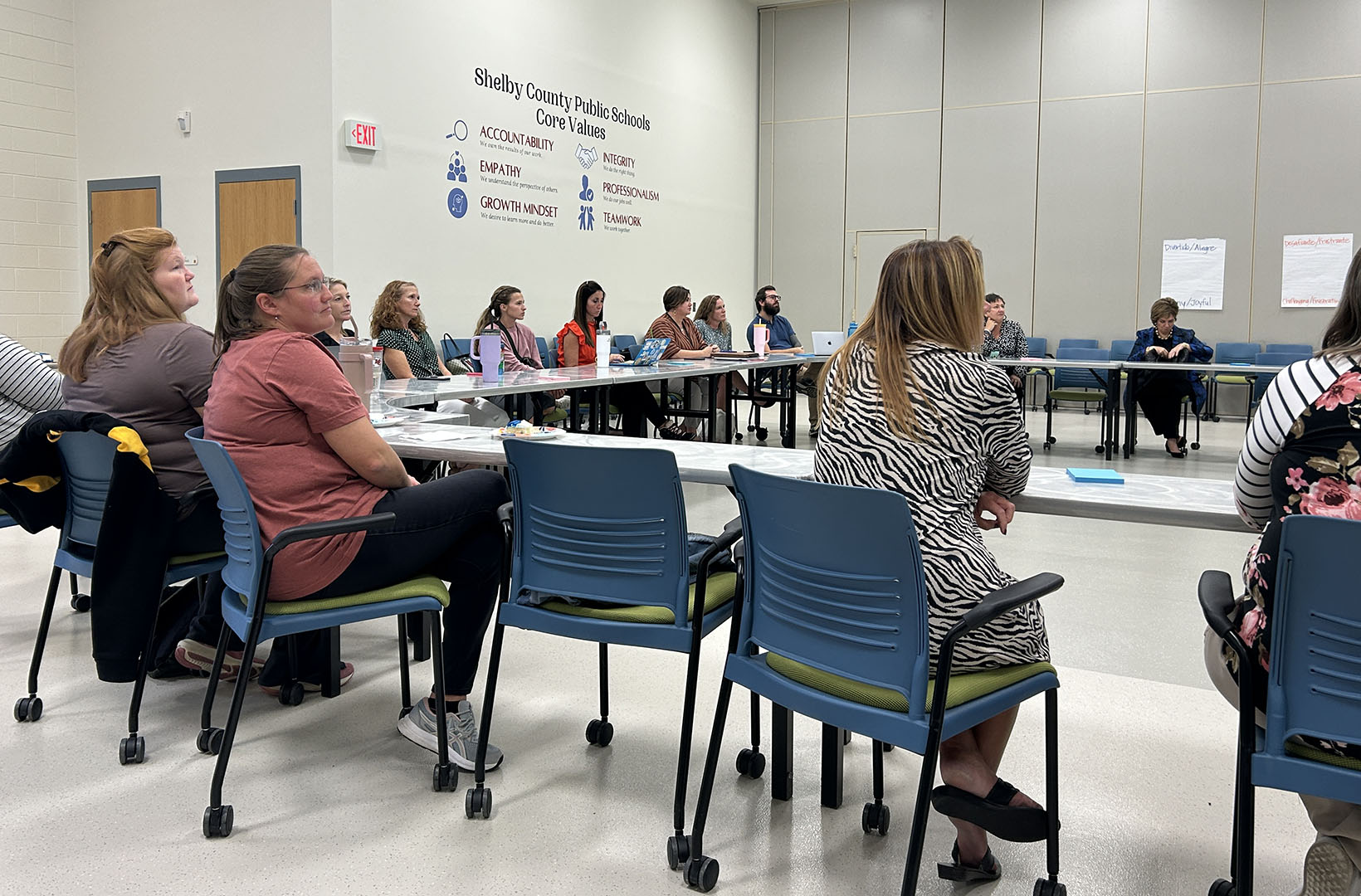This article is the fifth in a series of seven that focus on the core practices of world languages instruction. This series will try to open a window for world languages teachers, nontraditional world languages teachers and other educators as to what world languages education is about. The series will focus on two goals: to grow new leaders in the language learning profession, and to foster growth in students and teachers through effective instructional practices in language teaching.
Read the series:
- World languages: Strengthen your core!
- Core practices: Using the target language as the vehicle and content of learning
- Core practices: Fostering interpersonal communication
- Core practices: Backward design of world language curriculum
- Core practices: Using authentic texts and resources
- Core practices: Provide feedback to improve learner performance
By Lisa Harris
Lisa.Harris@doe.virginia.gov
The words that make every language teacher cringe. You know the ones; we’ve all heard some variation of them many times.
– “I took four years of German and don’t remember a word of it.”
– “I studied Spanish all through high school and the only thing I can say is ‘hola.’”
– “I can’t speak a word of French, but I can conjugate a verb like crazy.”
We hear statements like these a lot. But what can we, as language professionals, do to improve the chances that learners will leave us with at least some proficiency in the target language, and thus lessen the instances of hearing these dreaded words? Finding an answer requires us to examine our classroom practices and look for ways to better create the conditions for acquiring language.
At the inaugural Leadership Initiative for Language Learning (LILL) Institute held in 2015, Eileen Glisan – an American Council on the Teaching of Foreign Languages past president and author of “The Teacher’s Handbook” – introduced participants to six Core Practices for language teachers. If you have been following this series, you have already read about three of the Core Practices.
This next core practice focuses on an area that, in the words of language acquisition expert John De Mado, “standardly divides our profession.” Nothing gets us going like a good discussion on the role of grammar in the language acquisition process. I love grammar. But love of grammar for its own sake aside, the first question we should be asking of ourselves isn’t whether or not grammar is important. It is. The first question should be more along the lines of, “what do we want our students to know and be able to do when they leave our classes?”
When we focus on the desired outcomes, the conversation changes. “Acquiring language isn’t about finding the right or wrong answer; it’s about making meaning,” says noted author and educator Eileen Glisan. With this in mind, the question becomes more about how to plan learning experiences that lead to the identified goal.
Here is where the conversation starts to get interesting. While we mostly agree on the desired outcome, the next step is less clear. What role does grammar play in getting us there and how do language teachers guide the process?
Consider this quote by Bonnie Adair-Hauck and Richard Donato in The PACE model: A story-based approach to meaning and form for standards-based language learning:
“An important role of the language teacher is to create learning situations in which students perceive how grammar can be used to comprehend and interpret the target language and how to use grammar in meaningful exchanges. In other words, learners need to understand how grammar will enable them to become meaning-makers.”
I also like De Mado’s take on this. He says, “In the language acquisition process, it would be advantageous for us to view grammatical accuracy as a destination rather than a starting point.” You can read more about his thoughts on this in his article, “Considering the Role of Grammar in the Language Acquisition Process.”
So if grammar is not the starting point, then what role does it play? There is a growing body of research that supports a more nuanced approach to incorporating grammar. A recent article out of the University of Nebraska concludes: “There are many factors to consider when deciding how to teach grammar in the language classroom, such as age, learner styles, educational objectives, cultural background, topic familiarity and visual enhancements.”
How then do we go about the business of teaching for proficiency while meeting the needs of diverse learners, working toward accuracy, monitoring progress and building communication skills? Following the principles of Backward Design, we plan learning experiences that incorporate grammar as a concept and use it in context. According to ACTFL, “instead of focusing on grammar rules and diagramming sentences, teachers should guide students towards an understanding of how grammar functions. Students learn how to use the form rather than memorized conjugations that may not be applicable across contexts.”
In the traditional approach to grammar instruction, teachers would include various activities focused on mastery of discrete grammar elements. Perhaps a “Grammar Point of the Day” or a textbook explanation of a rule followed by mechanical practice. The practice was likely also a textbook or workbook exercise with the main goal of demonstrating mastery of the grammar point, which was then supposed to transfer to language production.
This deductive approach has not been shown to lead to language proficiency, since it is not tied to the point we made earlier – acquiring language is about making meaning. Discrete grammar exercises have little connection to making meaning and provide little motivation for students to retain the learning.
So, if discrete grammar teaching isn’t effective, what is? There are a number of methods out there and it may take some time and research to find the one that works best in your context. One research-based approach is the P.A.C.E. model. P.A.C.E. stands for Presentation, Attention, Co-Construct and Extension.
P.A.C.E. is a story-based approach to grammar teaching that focuses on the forms of the grammar structure only after having students focus on the meaning. The model provides a concrete way to teach grammar as a concept by having teacher and learners attend to patterns and co-construct a grammar explanation after focusing on the meaning in context.
This article from the World Language Classroom on The PACE Model: Teach Foreign Language Grammar Inductively as a Concept does a nice job of summarizing the approach:
- PRESENTATION: The teacher foreshadows the grammar structure with an appropriate text, with emphasis on meaning. Typically, the teacher recycles the storyline through pictures, total physical response (TPR) activities, etc., to increase comprehension and student participation. The focus is not on the grammar structure at this point, but it is used by the teacher and in the text.
- ATTENTION: The teacher now has students focus on the language form or structure through the use of images, PowerPoint slides or highlighting a particular linguistic form.
- CO-CONSTRUCTION: After the teacher has focused student attention on a particular target-language form, together they co-construct the grammatical explanation. The teacher provides scaffolding and assists the learners with questions that encourage them to reflect, predict and form generalizations regarding the consistencies of the language. Students construct their own grammar rules guided by the teacher, who will make sure that they end up with an appropriate explanation.
- EXTENSION: The learners use the grammatical structures to complete a task relating to the theme of the lesson, which helps the language remain communicative while also highlighting a particular structure.
For more information on the practical applications of the P.A.C.E. model and teaching grammar as a concept, check out these resources:
- LangTalks webinar: “Teaching Grammar: Concept and Use in Context” by Laura Terrill
- The Teaching French Grammar website gives a nice description, sample lesson and step-by-step guide on writing a P.A.C.E. lesson. It also has a checklist to help with planning. Examples are in English and applicable to all languages.
- Cambridge University Press blogpost: “Six core practices #4 – Teach grammar as concept and use in context.”
- “Using a Story-based Approach to Teach Grammar,” by Bonnie Adair-Hauck and Richard Donato
For more in-depth explanations and research on teaching grammar as a concept, try these resources:
- “The PACE Model: A story-based approach to meaning and form for standards-based language learning,” by Bonnie Adair-Hauck and Richard Donato, The French Review, Volume 76.
- Lee, J. F. & VanPatten, B. (2003). Making communicative language teaching happen, 2nd edition. New York, NY: McGraw-Hill, Inc.
- “Can We Learn a Language Without Rules?” by Aleidine Kramer Moeller and Olha Ketsman, University of Nebraska-Lincoln Faculty Publications: Department of Teaching, Learning and Teacher Education.
- Shrum, J. & Glisan, E. (2005). Teacher’s handbook: Contextualized language instruction. Boston, MA: Heinle & Heinle.
Lisa A. Harris is currently the specialist for foreign languages and international education at the Virginia Department of Education and executive treasurer of the National Council of State Supervisors for Languages (NCSSFL). Harris has been in the education field for 25 years, serving as a classroom teacher, assistant principal, coordinator for foreign languages, director for curriculum and instruction, and project manager for school improvement. She is a 2011 fellow of the Educational Policy Fellowship Program and serves on numerous boards and committees, including co-chair of the NCSSFL-ACTFL task force revising the Can-Do statements for language and was named Supervisor of the Year in 2015 by NCSSFL.



Leave A Comment